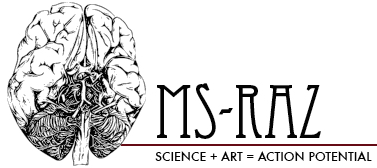Face or Vase?
Take a look at the image (place). This image raises a few questions. What do you see? Do you see a face? A vase? A couple faces? Now that I’ve made those suggestions are you switching between them? Which one is the “correct” image?
Well, as you might have guessed, both are “correct”, but your perception of them is probably a bit mixed. This adapted illusion is known as the “Rubin Vase”, created by Edgar Rubin in 1915. It is an example of an ambiguous bi-stable image, meaning it has two different states, face or vase. Images like this have been used in perceptual experiments for years. What can these images teach us about the brain?
One brain works hard to achieve stability by taking in sensory input and making sense of it all. Sometimes that input is a bit ambiguous. Early on in the visual process, in the primary visual cortex (V1), features such as contour and contrast are determined with specialized cells. The information from these cells is relayed to higher-level visual areas to understand and categorize what is being seen. What, then, does the brain do when it is faced with two perceptually “correct” experiences? Do the two configurations fight for our perceptual attention? How does one “win”? Do you blend the two? Can you? Try it with the image. Can you see the faces and the vase simultaneously?
Probably not. So what is happening when you see two faces then suddenly switch to see a vase? Could this change be observable in the brain? Lucky for us aspiring neuroscientists, yes! For example, when you see the faces in the Rubin figure, the fusiform “face area” of your brain is more strongly activated (Andrew, et al. 2002). This area in the temporal and occipital lobes is activated when viewing and interpreting faces. But what is happening when the perception “switches” between a face object and an inanimate different categorical vase object?
As far as actual perceptual bits of information in the lower levels (V1), nothing is changing when you suddenly see a face over a vase or vise versa because the stimulus hasn’t changed. Then what is changing? And where? Tomohiro Ishizu and Semir Zeki of University College London (2014) set out to investigate these questions by asking participants to press a button when they perceived the figure to “flip” while they were in an fMRI scanner. They found activation in frontal and parietal brain areas, which suggest some top-down processes are modulating the lower level visual cortex areas. (See the Kanizsa Triangle article for more on top-down and bottom-up processing.) Of particular interest was the activation of the superior temporal gyrus, involved in auditory and social cognition processing, and the anterior cingulate cortex (ACC). The ACC connects to areas in the prefrontal cortex, parietal cortex, amygdala, hypothalamus, and the insular cortex to name a few. Needless to say, it is a highly interconnected little strip of brain tissue. The ACC is involved in many processes such as error-detection and conflict resolution. In this task, it was activated during the switching/reversal.
From these results, it appears there are higher order areas of the brain monitor conflicting input and come to tentative conclusions, in an attempt to create consistency and stability. The results are salient and intriguing but researchers are far from concluding exactly how these areas “decide” when and how to switch. Ideally, in the future new scanning and imaging techniques will be developed, which will give us more insight into these intricate neurological processes. When that happens, we may very well still be using these simple yet elegant, ambiguous figures as stimuli to give us more insight into our sophisticated three-pound mass we call the brain.
But for now, look at some of the ambiguous figures throughout the article and appreciate the seamless switching your brain appears to effortlessly accomplish.
Enjoy!
Activity in the fusiform gyrus predicts conscious perception of Rubin's vase-face illusion. Andrews, Timothy J; Schluppeck, Denis; Homfray, Dave; Matthews, Paul; Blakemore, Colin (2002) NeuroImage vol. 17 (2) p. 890-901
Varieties of perceptual instability and their neural correlates
Ishizu, Tomohiro; Zeki, Semir (2014) NeuroImage vol. 91 p. 203-209

